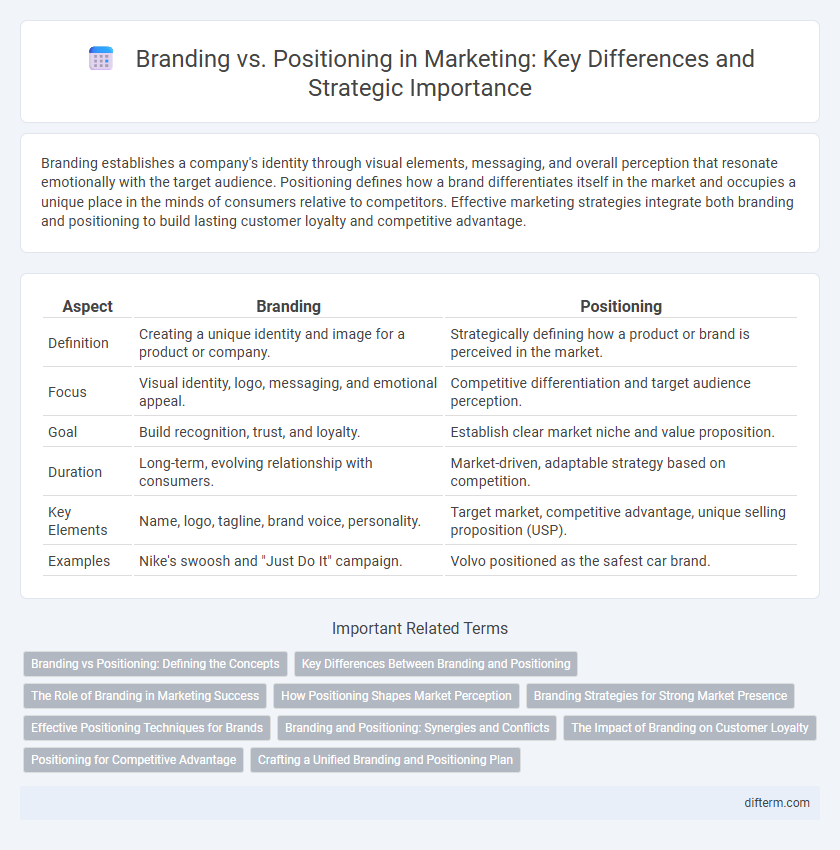Branding establishes a company's identity through visual elements, messaging, and overall perception that resonate emotionally with the target audience. Positioning defines how a brand differentiates itself in the market and occupies a unique place in the minds of consumers relative to competitors. Effective marketing strategies integrate both branding and positioning to build lasting customer loyalty and competitive advantage.
Table of Comparison
| Aspect | Branding | Positioning |
|---|---|---|
| Definition | Creating a unique identity and image for a product or company. | Strategically defining how a product or brand is perceived in the market. |
| Focus | Visual identity, logo, messaging, and emotional appeal. | Competitive differentiation and target audience perception. |
| Goal | Build recognition, trust, and loyalty. | Establish clear market niche and value proposition. |
| Duration | Long-term, evolving relationship with consumers. | Market-driven, adaptable strategy based on competition. |
| Key Elements | Name, logo, tagline, brand voice, personality. | Target market, competitive advantage, unique selling proposition (USP). |
| Examples | Nike's swoosh and "Just Do It" campaign. | Volvo positioned as the safest car brand. |
Branding vs Positioning: Defining the Concepts
Branding establishes a company's identity through visual elements, voice, and values that create emotional connections with the audience. Positioning defines how a brand is perceived relative to competitors by emphasizing unique benefits and market niche. Effective marketing strategies integrate branding and positioning to build recognition and competitive advantage.
Key Differences Between Branding and Positioning
Branding establishes a company's identity through visual elements, tone, and core values that create emotional connections with customers. Positioning defines how a brand is perceived relative to competitors by emphasizing unique selling propositions in the target market. While branding shapes overall customer experience, positioning strategically targets market segments to differentiate the brand's value.
The Role of Branding in Marketing Success
Branding establishes a unique identity and emotional connection with customers, crucial for long-term market recognition and loyalty. Strong brands differentiate products in competitive markets, enhancing perceived value and allowing premium pricing strategies. Effective branding supports positioning by reinforcing the company's promise and aligning customer expectations with the brand experience.
How Positioning Shapes Market Perception
Positioning shapes market perception by clearly defining how a brand is distinguished in the minds of consumers relative to competitors. It influences consumer decision-making by emphasizing specific attributes, benefits, or values that resonate with the target audience. Effective positioning creates a unique space in the market, enhancing brand recognition and driving customer loyalty.
Branding Strategies for Strong Market Presence
Branding strategies that create a strong market presence emphasize consistent visual identity, compelling brand messaging, and emotional connections with target audiences. Effective branding leverages logos, color schemes, and storytelling to foster brand recognition and loyalty. Prioritizing authenticity and customer engagement helps differentiate a brand from competitors and enhances its perceived value in the marketplace.
Effective Positioning Techniques for Brands
Effective positioning techniques for brands involve clearly defining the unique value proposition that differentiates the brand from competitors, ensuring it resonates with the target audience's needs and preferences. Utilizing market research data and consumer insights enables precise messaging that communicates the brand's benefits and fosters emotional connections. Consistent brand positioning across all marketing channels strengthens brand identity and builds lasting customer loyalty.
Branding and Positioning: Synergies and Conflicts
Branding establishes a company's identity through visual elements, messaging, and emotional appeal, creating a lasting impression on the target audience. Positioning strategically differentiates products or services within the market to influence consumer perception and competitive advantage. Synergies arise when consistent branding reinforces positioning, while conflicts occur if branding promises diverge from market positioning, causing consumer confusion.
The Impact of Branding on Customer Loyalty
Branding establishes a strong emotional connection with customers by consistently delivering a clear identity, which significantly boosts customer loyalty and retention. Effective branding increases perceived value, making customers more likely to choose and advocate for a specific brand over competitors. Strong brand equity leads to higher customer lifetime value and creates a competitive advantage that positioning alone cannot achieve.
Positioning for Competitive Advantage
Positioning establishes a brand's unique place in the market by aligning products and services with specific customer needs and preferences, creating a clear competitive advantage. Unlike branding, which shapes overall perception and identity, positioning targets consumer decision-making by highlighting distinctive benefits and value propositions. Effective positioning drives market differentiation, enhances customer loyalty, and supports sustainable growth amidst intense competition.
Crafting a Unified Branding and Positioning Plan
Crafting a unified branding and positioning plan involves aligning your brand identity with a clear market position to create consistent messaging that resonates with target audiences. This approach ensures that your brand values, visual elements, and voice reinforce your unique value proposition, enhancing brand recognition and customer loyalty. Effective integration of branding and positioning strategies drives competitive advantage by clearly differentiating your offerings in the marketplace.
Branding vs Positioning Infographic

 difterm.com
difterm.com